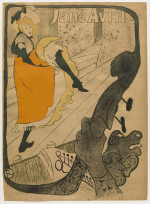Column Name
Title
Subhead
The lively atmosphere created by the Museum of Modern Art’s show The Paris of Toulouse-Lautrec: Prints and Posters (through March 22) made me feel as if I had just walked into fin-de-siècle Paris, better known as the Belle Époque. The curator has thoughtfully augmented the Art Nouveau atmosphere of the artist’s whiplash lines and sinuous curves with video and audio clips as well as photographs. One video from 1902 shows cancan dancers at the Moulin Rouge; Lautrec’s lithograph of the scene hangs next to it. The songs of Yvette Guilbert (Toulouse-Lautrec celebrated the cabaret singer in numerous prints and posters) are heard throughout the galleries. Even if you don’t understand French, it’s not hard to guess at how bawdy and naughty they were. And another video shows a dancer performing the serpentine dance, inspired by the American Art Nouveau dancer Loie Fuller, who was also one of Lautrec’s frequent subjects.
Body
More than a century after Henri de Toulouse-Lautrec’s death, at the age of 36 in 1901, his posters made for businesses and street kiosks, which had a huge influence on printmakers of his day, are still popular.
Toulouse-Lautrec was born in 1864 and due to congenital birth defects fractured both legs as a young teenager. He stood barely 5 feet tall and his torso was normal sized, but his legs were short and he used a cane to walk. Unable to participate in riding, dancing, or other physical activities of his peers, he turned his repressed energy into ardent spectatorship. He regularly frequented café-concerts, the theater, and brothels, where little escaped him. Although born into an aristocratic family, he was a populist, saying that he lived the lives of both an aristocrat and a wild Bohemian. The sleazy and the bawdy, enthralled him more than simple beauty and elegance.
The first poster that meets our eyes at the MoMA show is the marvelous and imposing 1893 lithograph Aristide Bruant in his Cabaret. The curve of Bruant’s eyebrow echoes the sneer on his lips, the lines of his ear, his large black hat, the curls of his hair, his trademark red scarf, and the snakelike outlines of his cape. On the walls nearby hang several photographs by the renowned Eug`ene Atget (1857-1927) of the Moulin Rouge and other places Toulouse-Lautrec frequented.
The exhibition is organized thematically, and one part is devoted to café-concerts and dance halls—by 1896, Paris had about 300 of these nightspots. Havens for prostitution, they were also places people could meet, smoke, drink, dance, and act out fantasies. Notorious venues include the Moulin Rouge, Les Ambassadeurs, and the Moulin de la Galette, all of which were celebrated by Toulouse-Lautrec and other Post-Impressionists. Another section focuses on the numerous female performers Lautrec befriended and memorialized. It includes sympathetic portrayals of prostitutes at leisure, many of whom were lesbians and Toulouse-Lautrec’s friends. A third section uses song sheets, theater and café programs, and book and magazine illustrations to give a sense of Toulouse-Lautrec and his circle. There are some somber scenes amid the gaiety, including a macabre lithograph of a hanged man.
In the café-concert lithographs in the first part of the exhibition, Fellini-esque clowns, and deformed people mix with smart dressers and flâneurs (well-dressed male strollers with walking sticks who had nothing better to do than observe the streets of Paris).
Standouts in the show include the large 1893 poster that the performer Jane Avril commissioned to advertise her cabaret act. A color lithograph that’s more than 4 feet high and 3 feet wide, it exemplifies Art Nouveau. The shape of the scroll of the double bass at the right is complemented by its pegs, the musical score with curvy clefs, and a hard-to-decipher bespectacled head of the player behind it, his ear and hair echoing the stylized rhythms. A line (is it the music?) comes out of the instrument and encircles both the cancan dancer, with her sinuous position, her petticoats, her shoes and headpiece; and her simply printed name in large capital letters. The poster is a tour-de-force.
Other justly famous posters include that of the singer Yvette Guilbert, wearing her trademark long black gloves; the English May Belfort, her suggestive black cat snuggled in her arms; and La Goulue (the glutton) with her much-imitated hairdo.
Like so many artists of his day, Toulouse-Lautrec took abundant inspiration from the Japanese woodblock prints known as ukiyo-e (the floating world). Both forms emphasized lines and flat color areas; content-wise, the Japanese celebration of kabuki performers and beautiful women resonated in Toulouse-Lautrec’s cabaret performers and dancers. Indeed, he compressed his initials, H.T.L., into a character inside a circle to form a Japanese-style seal to sign his prints.
I have always loved the work of Toulouse-Lautrec, but I am often astonished by how many of my art history students at Juilliard don’t know it. This succinct show presents a great opportunity to rectify that situation.





